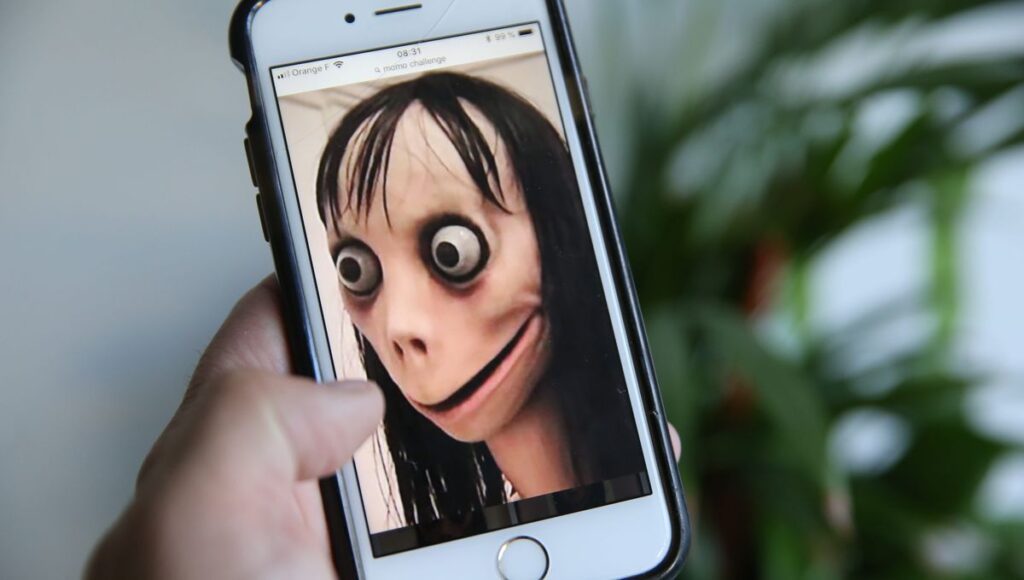No, the “Momo Challenge” does not push young people to suicide

A viral phenomenon that has been circulating on the Internet since the summer of 2018, under the name of “Momo Challenge”, is said to encourage young people to take their own lives. Suicide prevention experts say instead that it is an urban legend and that no deaths can be attributed to this phenomenon.
The “Momo Challenge”, or Momo challenge, is said to consist of a message spread on social networks in which a gloomy-looking woman threatens her targets and orders them to commit suicide. The person behind the message is represented by a sculpture by Japanese artist Keisuke Aisawa.
According to screenshots of conversations on the WhatsApp messaging service, participants are invited to dial a telephone number to participate in the Momo challenge. In recent days, parents have claimed that the image associated with the Momo challenge is now found in YouTube videos for children. Since then, worried parents, police forces and school administrations

YouTube has denied that videos promoting the Momo Challenge were on its platform and has assured that it will immediately remove them if they are.
ELSEWHERE ON INFO: Criticizing Extractivism Through Art
No Suicides Directly Linked to the Momo Challenge
When the phenomenon began to circulate, Argentinian media reported that a 12-year-old girl had taken her own life after playing the Momo Challenge. However, after investigation, the Argentinian police suspected an 18-year-old boy of having incited her to commit the act.
Other cases of suicide in Colombia and India have been attributed to the Momo Challenge, according to local authorities. However, it is very difficult to draw such conclusions, according to Louis-Philippe Côté, member of the Research and Intervention Center on Suicide, Ethical Issues and End-of-Life Practices at the Université du Québec à Montréal.
“For the police or the coroner to say: ‘This young person committed suicide because he played this game’, the evidence would have to be very high, and it is not necessarily easy evidence to collect in a case of suicide,” explains the researcher, who points out that suicide is a complex phenomenon with multiple causes.
In 2017, a similar challenge, the “Blue Whale Challenge”, was accused of leading to 130 suicides in Russia. However, an investigation by Radio Free Europe (New window) concluded that these allegations were unfounded and that no deaths could be linked to the “Blue Whale Challenge”.
There is no game, software or application that has the power to make someone suicidal, or to push that person to take action.
A quote from Louis-Philippe Côté, member of the Centre for Research and Intervention on Suicide, Ethical Issues and End-of-Life Practices, at the Université du Québec à Montréal
Louis-Philippe Côté is categorical: no suicide can be directly attributed to such web phenomena. He describes the situation as “collective paranoia”.
“We are fueling the kind of urban legend, the kind of piper tale of the year 2020, in which there would be a game that could seduce our children or hypnotize them to the point that it would make them suicidal. So, all of that is false.”

Beware of cyberbullying
According to Mr. Côté, even if the Momo challenge did not cause any suicides, it is not harmless. Cyberpredators can create profiles with the Momo character avatar, then use it to intimidate young people or try to obtain their personal information.
The phenomenon is not the Momo Challenge or the Blue Whale Challenge. The phenomenon is an adult who is a predator and who contacts a young person and blackmails them. It can be sextortion, it can be threats or things like that, and that is the real phenomenon. We are talking about cybercrime.
A quote from Louis-Philippe Côté, member of the Centre for Research and Intervention on Suicide, Ethical Issues and End-of-Life Practices, at the Université du Québec à Montréal
On this subject, Louis-Philippe Côté has three pieces of advice for young people: do not contact strangers on the Internet, do not share personal information online and do not hesitate to ask for help if you are a victim of cyberbullying.
Advertisement
From comics to Dungeons & Dragons
The fear that popular phenomena would lead to suicides existed even before the advent of the Internet. The director of the University of New Hampshire’s Crimes Against Youth Research Center, David Finkelhor, published a report in 2011 on what he calls “juvenoïa” (New window), a neologism composed of the words “juvenile” and “paranoia.” According to him, every new technology is accompanied by an “exaggerated fear” of its social influence on children and adolescents.
In his report, the author explains that such fears were already evident in the 1950s, when some accused comic books of leading to juvenile delinquency.
In the 1980s, parents blamed the role-playing game Dungeons & Dragons (New window) for being responsible for adolescent suicides.
The arrival of the Internet has exacerbated these kinds of fears among parents, according to David Finkelhor. The researcher emphasizes that this fear is unfounded, since statistics show that the suicide rate among young people in the United States has been falling sharply since the early 1990s.


